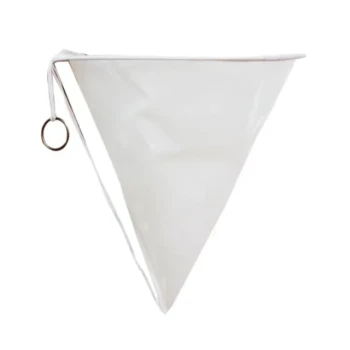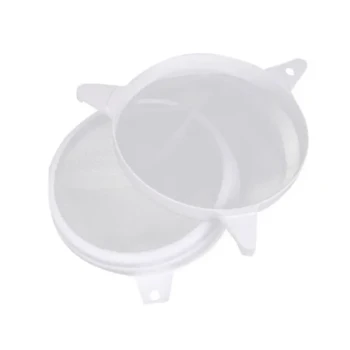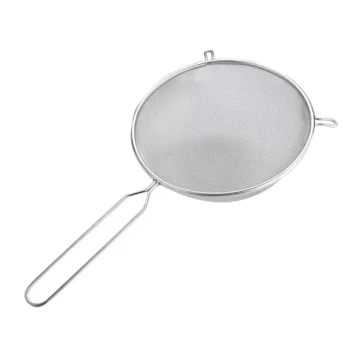Toggle Categories
Get Instant Support
Choose your preferred way to connect with our team
-
Get Free Quote Fill out form for detailed pricing
-
Send Email Detailed inquiry support
-
WhatsApp Quick mobile chat
Response Time
Within 8 hours on working days, 24 hours on holidays
Honey Filters & Strainers

Stainless Steel Double Layer Honey Strainer Sieve Filters
Item Number : HS-1

Nylon Honey Strainer Square Filter Cloth for Honey Filters
Item Number : HS-2

Conical Nylon Honey Strainer Filter Bag for Beekeeping and Honey Filtration
Item Number : HS-3

Stainless Steel Triangle Support Honey Strainer and Filters
Item Number : HS-4

Professional Cone-Shaped Honey Filter with Reinforced Steel Ring
Item Number : HS-3R

Professional Honey Filter with Tripod Support Stand
Item Number : HS-3S

Two-Stage Plastic Honey Filter for Buckets
Item Number : HS-5

Professional Stainless Steel Honey Filter with Support Handle
Item Number : HS-6
REQUEST A QUOTE
Our professional team will reply to you within one business day. Please feel free to contact us!
Related Articles

The Hidden Threat After Harvest: Why a Simple Lid Prevents Apiary Disaster
Discover how failing to replace honey container lids immediately after harvest triggers devastating "honey robbing," leading to colony collapse and disease spread, and learn how HONESTBEE's secure equipment protects your apiary.

How to Choose the Best Queen Excluder: Balancing Durability, Cost, and Bee Welfare
Learn how to choose the best queen excluder for durability, cost, and bee welfare. Compare stainless steel vs. plastic for hive efficiency.

Why Plastic Queen Excluders Outperform Metal and Wood: Science, Savings, and Hive Protection
Discover why plastic queen excluders outperform metal and wood in durability, hive health, and cost savings for modern beekeeping.

Mastering the Craft: A Professional's Guide to Calibrating Your Honey Refractometer

How Queen Excluders Optimize Hive Productivity and Honey Quality
Learn how queen excluders optimize hive productivity and honey quality in modern beekeeping. Discover mechanics, benefits, and best practices.

How Honey Bottle Designs Combine Convenience, Safety, and Sustainability
Explore modern honey bottle designs that balance convenience, safety, and sustainability for mess-free use and eco-friendly packaging.

Honey Flow vs. Langstroth Hives: Which System Delivers Better Efficiency and Bee Health?
Compare Honey Flow vs. Langstroth hives for efficiency, bee health, and economic impact. Ideal for commercial beekeepers choosing hive systems.

How to Accurately Test Honey Readiness: Science-Backed Methods for Beekeepers
Learn science-backed methods to test honey readiness, from bee behavior to refractometer use, ensuring optimal harvest timing and quality.

How Floral Composition Shapes Honey Texture: Managing Crystallization for Perfect Consistency
Learn how floral sources affect honey crystallization and discover expert techniques to control texture for perfect consistency.

Optimizing Honey Filtration: How Mesh Sizes Shape Quality and Market Appeal
Learn how honey filter mesh sizes (100-600 micron) impact clarity, nutrients, and market appeal for artisanal, health food, and bulk buyers.

How Modern Bee Suits Combine Safety and Comfort Through Smart Design
Discover how modern bee suits blend advanced fabrics and ergonomic design for unbeatable protection and comfort in beekeeping.

How Top Bar Hives Deliver Sustainable Honey Harvesting for Healthier Bees
Discover how top bar hives promote sustainable beekeeping with lower costs, healthier bees, and pure honey. Ideal for eco-conscious beekeepers.

How to Harvest Honey Naturally: A Beekeeper’s Guide to Crush & Strain
Learn the crush & strain method for natural honey harvesting—ideal for small-scale beekeepers prioritizing sustainability and comb purity.

Comb Honey: Why It Commands Premium Prices and How to Verify Purity
Discover why comb honey is nature's purest form, its premium value, and how to verify authenticity. Learn about artisanal production and certifications.

How Honey Storage Science Preserves Nutrients: Temperature, Light & Container Insights
Science-backed honey storage guide: Learn how temperature, light, and containers affect nutrient preservation, crystallization, and enzyme activity.

Raw Honey vs. Processed Honey: Evidence-Based Health Benefits Compared
Raw honey retains 30-50% more antioxidants and enzymes than processed honey, offering superior digestive, immune, and antibacterial benefits.

How to Safely Restore Crystallized Honey Without Losing Nutrients
Learn safe methods to restore crystallized honey while preserving nutrients, enzymes, and flavor. Ideal for glass or plastic containers.

How Bee Jackets Outperform Full Suits in Hot Weather Without Sacrificing Protection
Discover why bee jackets offer better heat management, mobility, and cost-efficiency than full suits for beekeepers in hot weather.

How Thoughtful Pocket Design Transforms Hive Inspections for Beekeepers
Discover how ergonomic pocket design in beekeeping suits enhances hive inspections, improves efficiency, and reduces stress for beekeepers.

How Honey Heating Tanks Preserve Quality and Efficiency in Modern Beekeeping
Discover how honey heating tanks preserve quality and efficiency in beekeeping with precise temperature control and scalable designs.